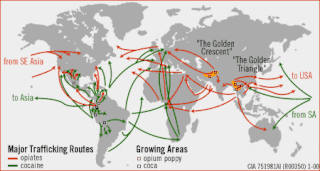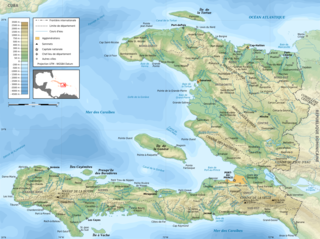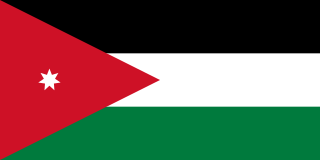Related Research Articles
The recorded history of Haiti began in 1492, when the European captain and explorer Christopher Columbus landed on a large island in the region of the western Atlantic Ocean that later came to be known as the Caribbean. The western portion of the island of Hispaniola, where Haiti is situated, was inhabited by the Taíno and Arawakan people, who called their island Ayiti. The island was promptly claimed for the Spanish Crown, where it was named La Isla Española, later Latinized to Hispaniola. By the early 17th century, the French had built a settlement on the west of Hispaniola and called it Saint-Domingue. Prior to the Seven Years' War (1756–1763), the economy of Saint-Domingue gradually expanded, with sugar and, later, coffee becoming important export crops. After the war which had disrupted maritime commerce, the colony underwent rapid expansion. In 1767, it exported indigo, cotton and 72 million pounds of raw sugar. By the end of the century, the colony encompassed a third of the entire Atlantic slave trade.

British Honduras was a Crown colony on the east coast of Central America, south of Mexico, from 1783 to 1964, then a self-governing colony, renamed Belize in June 1973, until September 1981, when it gained full independence as Belize. British Honduras was the last continental possession of the United Kingdom in the Americas.

The illegal drug trade or drug trafficking is a global black market dedicated to the cultivation, manufacture, distribution and sale of prohibited drugs. Most jurisdictions prohibit trade, except under license, of many types of drugs through the use of drug prohibition laws. The think tank Global Financial Integrity's Transnational Crime and the Developing World report estimates the size of the global illicit drug market between US$426 and US$652 billion in 2014 alone. With a world GDP of US$78 trillion in the same year, the illegal drug trade may be estimated as nearly 1% of total global trade. Consumption of illegal drugs is widespread globally, and it remains very difficult for local authorities to reduce the rates of drug consumption.

The United States occupation of Haiti began on July 28, 1915, when 330 U.S. Marines landed at Port-au-Prince, Haiti, after the National City Bank of New York convinced the President of the United States, Woodrow Wilson, to take control of Haiti's political and financial interests. The July 1915 invasion took place following years of socioeconomic instability within Haiti that culminated with the lynching of President of Haiti Vilbrun Guillaume Sam by a mob angered by his decision to order the executions of political prisoners. The invasion and subsequent occupation was promoted by growing American business interests in Haiti, especially the National City Bank of New York, which had withheld funds from Haiti and paid rebels to destabilize the nation through the Bank of the Republic of Haiti with an aim at inducing American intervention.

Non-tariff barriers to trade are trade barriers that restrict imports or exports of goods or services through mechanisms other than the simple imposition of tariffs. Such barriers are subject to controversy and debate, as they may comply with international rules on trade yet serve protectionist purposes.

The trans-Atlantic trade in deerskins was a significant commercial activity in Colonial America that was greatly influenced, and at least partially dominated, by Scottish traders and their firms. This trade, primarily in deerskins but also in beaver and other animal pelts, was carried on with Native American tribes and is usually referred to as the Indian Trade. The Indian trade was conducted largely to fill the high European and later colonial demand for deerskins and other animal pelts trapped by Indians in return for European trade goods. These pelts were shipped to Europe and used in the leather-making industry. The trade had been developing since the seventeenth century and Scottish traders played an important part in its advance.

Canada–Caribbean relations are the long established relationships between Canada and the many states of the Caribbean or West Indies. These ties have been on-going throughout the history of both regions. Initially these relations were based on the policies of European colonial powers in the Americas. More recently, both Canada and most of the Caribbean islands have achieved self-government, putting their relations into a different phase. CARICOM diplomats have referred to Canada as a '"special friend" of the Caribbean at the regional and bilateral levels.' Ties exist in such plurality of organs such as: the Commonwealth of Nations, the Organisation internationale de la Francophonie, Organization of American States, ParlAmericas, the United Nations, and the World Trade Organization.

Social class in Haiti uses a class structure that groups people according to wealth, income, education, type of occupation, and membership in a specific subculture or social network. Since the colonial period as part of the colony of Saint-Domingue (1625–1804), race has played an important factor in determining social class.
The Commercial Import Program, sometimes known as the Commodity Import Program (CIP), was an economic aid arrangement between South Vietnam and its main supporter, the United States. It lasted from January 1955 until the Fall of Saigon in 1975 and the dissolution of South Vietnam following the invasion by North Vietnam after US forces had withdrawn from the country due to the 1973 cease-fire agreement.

The Swahili coast is a coastal area of East Africa, bordered by the Indian Ocean and inhabited by the Swahili people. It includes Sofala ; Mombasa, Gede, Pate Island, Lamu, and Malindi ; and Dar es Salaam and Kilwa. In addition, several coastal islands are included in the Swahili coast, such as Zanzibar and Comoros.

The Haiti indemnity controversy involves an 1825 agreement between Haiti and France that included France demanding an indemnity of 150 million francs to be paid by Haiti in claims over property – including Haitian slaves – that was lost through the Haitian Revolution in return for diplomatic recognition, with the debt removing $21 billion from the Haitian economy. The first annual payment alone was six times Haiti's annual revenue. The payment was later reduced to 90 million francs in 1838, equivalent to $32,535,940,803 in 2022, with Haiti paying about 112 million francs in total. Over the 122 years between 1825 and 1947, the debt severely hampered Haitian economic development as payments of interest and downpayments totaled a significant share of Haitian GDP, constraining the use of domestic financial funds for infrastructure and public services.

Macau was a Portuguese colony from the establishment of the first official Portuguese settlement in 1557 to its handover to China in 1999. It comprised the Municipality of Macau and the Municipality of Ilhas. Macau was both the first and last European holding in China.

Slavery in Haiti began after the arrival of Christopher Columbus on the island in 1492 with the European colonists that followed from Portugal, Spain and France. The practice was devastating to the native population. Following the indigenous Tainos' near decimation from forced labor, disease and war, the Spanish, under initial advisement of the Catholic priest Bartolomé de las Casas and with the blessing of the Catholic church, began engaging in earnest during the 17th century in the forced labor of enslaved Africans. During the French colonial period, beginning in 1625, the economy of Saint-Domingue, was based on slavery; conditions on Saint-Domingue became notoriously bad even compared to chattel slavery conditions elsewhere.

China–Senegal relations refer to the foreign relations between China and Senegal.

Jordanian nationalism is a nationalistic ideology that considers the Jordanian people a separate nation and strives to maintain Jordan as an independent nation-state. It emerged as one of three nationalist currents in the 1920s, and was opposed to both Palestinian nationalism present in the region, as well as the Hashemite Arab nationalism promoted by Abdullah I, the first ruler of the Emirate of Transjordan.
Rice production was an integral part of the Haitian economy, as it has been farmed in Haiti for over two hundred years. The origin of this rice has been traced back to West African agriculture. Rice is a staple food for most Haitians but it has become a commodity in the sense that Haiti is no longer self-sufficient in producing rice for the country. Haiti maintained dependency on their own agriculture of rice until the 1980s. In the mid-1980s Haiti was no longer producing substantial amounts of rice and by the 1990s Haiti held a greater reliance on imports rather than domestic rice production. The decline in rice production caused by policies under the Caribbean Basin Initiative had devastating consequences for Haiti's rural population. Many Haitian farmers, traders, and millers faced unemployment and relocation. Because farming was their livelihood, many could not find adequate work with their skill set. The Adoption of trade liberalization policies and environmental degradation are said to be the two factors that have caused Haiti's decline in rice production. These policies have lowered the rice import tariff so that it is now less than any other Caribbean nation. The tariff is at three percent, causing a dumping ground of rice in Haiti. Many accuse the United States of purposefully depositing all of their rice into Haiti. In 1985 the local rice production was at 163,296 metric tons while the US imports were only at 7,337 metric tons counting for a total of 170,663 metric tons. By 2000, local production had decreased to 130,000 metric tons while US imports ascended to 219,590 metric tons; in addition, since 1995 over $13 billion in subsidies have gone to rice exports. The result made Haiti inundated with subsidized rice imports while undercutting domestic production.
Brown v. Maryland, 25 U.S. 419 (1827), was a significant United States Supreme Court case which interpreted the Import-Export and Commerce Clauses of the U.S. Constitution to prohibit discriminatory taxation by states against imported items after importation, rather than only at the time of importation. The state of Maryland passed a law requiring importers of foreign goods to obtain a license for selling their products. Brown was charged under this law and appealed. It was the first case in which the U.S. Supreme Court construed the Import-Export Clause. Chief Justice John Marshall delivered the opinion of the court, ruling that Maryland's statute violated the Import-Export and Commerce Clauses and the federal law was supreme. He alleged that the power of a state to tax goods did not apply if they remained in their "original package". A license tax on the importer was essentially the same as a tax on an import itself. Despite arguing the case for Maryland, future chief justice Roger Taney admitted that the case was correctly decided.

The Republic of Haiti from 1859 to 1957 was an era in Haitian history plagued with political struggles, the period of American occupation and multiple coups and elections until the Duvalier dynasty seized control of the country in 1957.

The Indian Ocean slave trade, sometimes known as the East African slave trade or Arab slave trade, was multi-directional slave trade and has changed over time. Africans were sent as slaves to the Middle East, Indian Ocean islands, to Indian subcontinent, Java, and then to America.
The United States Government Fur Trade Factory System was a system of government non-profit trading with Native Americans that existed between 1795 and 1821.
References
- ↑ Haiti Drives out Syrian Merchants. The New York Times. Posted in December 21, 1911.